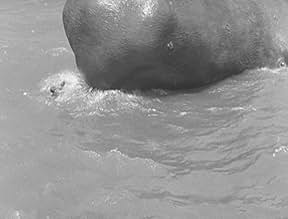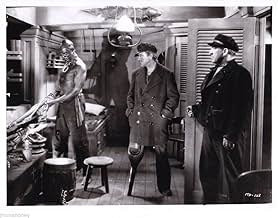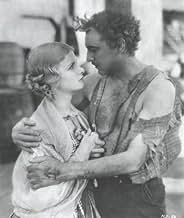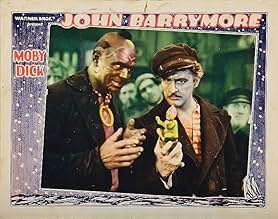In this extremely loose adaptation of Melville's classic novel, Ahab is revealed initially not as a bitter and vengeful madman, but as a bit of a lovable scamp. Ashore in New Bedford, he mee... Read allIn this extremely loose adaptation of Melville's classic novel, Ahab is revealed initially not as a bitter and vengeful madman, but as a bit of a lovable scamp. Ashore in New Bedford, he meets and falls for Faith Mapple, daughter of the local minister and beloved of Ahab's brothe... Read allIn this extremely loose adaptation of Melville's classic novel, Ahab is revealed initially not as a bitter and vengeful madman, but as a bit of a lovable scamp. Ashore in New Bedford, he meets and falls for Faith Mapple, daughter of the local minister and beloved of Ahab's brother Derek. Faith herself quickly returns Ahab's love, as Derek is drab and ignoble. On his n... Read all
- Director
- Writers
- Stars
- Awards
- 2 wins total
- Elijah
- (as Nigel de Brulier)
- Sailor on Board during storm
- (uncredited)
- Boy
- (uncredited)
- Sailor
- (uncredited)
- Sailor
- (uncredited)
- First Mate
- (uncredited)
- Fat Fanny on Dock
- (uncredited)
- Boy
- (uncredited)
- Shanghai Lady Seller
- (uncredited)
- Director
- Writers
- All cast & crew
- Production, box office & more at IMDbPro
Featured reviews
When the film begins, it's obvious that the Captain Ahab in the film isn't the one in the novel. Instead of being a stern, joyless man leader as Gregory Peck played him in 1956, Barrymore's Ahab is a common sailor....more like Popeye or Bluto! He's a fun-loving galoot with tattoos galore and a lust for life. But this happy demeanor does change when he later meets up with the whale, Moby Dick. There's also a romance...and I know most people do NOT think of this story as a romance!! But these aren't the only major changes from the book....the ending is also 100% different!! Apparently, the studio didn't like the novel very much and decided to very liberally change it.
In many ways, this is much more a John Barrymore film than a Herman Melville novelization. On the positive side, the novel is pretty dull reading...and this film isn't dull. But it also misses so much of the point of the story and instead is a showcase for Barrymore's flamboyant acting and personality.
So is it any good? Well, for American Literature professors, it's probably a bad choice of films to watch! Others, however, might enjoy it very much provided they don't care about the source material. The special effects, for 1930, are very impressive and the film captures the look of the 1840s quite nicely. A few scenes were actually lifted directly from "The Sea Beast" (such as when Ahab is attacked by the whale). And, the amputation scene is amazingly vivid and effective. My advice is to watch the film and enjoy it for what it is.
The precode elements in this filmed version include a heathen fellow whom Ahab becomes friends with and the fact that Ahab enlists the supernatural powers this fellow has via his gods on his worldwide quest to find and kill Moby Dick. You really have to marvel at the production values in this one. The sound mix is still Vitaphone - sound on disc - yet there are quite a few outdoor scenes and the film is not static at all. To put it mildly, the Warners were known for thrift, yet they took the time to make this one look good.
I don't understand the rather low rating on this one as I found it thoroughly entertaining and would recommend it for anyone who appreciates the early talkies and John Barrymore's acting talents.
Since this is a rearranging or reinventing of what Melville intended it would be fun to speculate if he would get a chuckle out of showing Ahab as a young man with both legs intact as well as having a female love interest. Purists don't like this tampering of Melville text but 1920s audiences were either ignorant or just didn't seem to mind good storytelling through the medium of motion pictures. Thus the part of Moby Dick concerning Ahab's dallying as a young man and his love for this girl Esther is enough to fill a prequel book or movie leading up to the famous encounter with the Great White Whale. The last part of the movie after they kill Moby Dick and Ahab lives and arrives back home to Esther is a far fetched sequel story in itself. I think Melville & everybody would disagree with the fact that Ahab lives but it would still be enough for a separate story and possibly leaving enough future story open for Ahab to perhaps hunt down and kill 'the son of Moby Dick'. In this age of Sequels & Prequels we live in , a surviving Ahab killing Moby's son is not pablum but perhaps just good fantasy story telling.
Did you know
- TriviaThis film featured an early, experimental use of widescreen known as Magnascope. As the boats were lowered for the first chase after the whale, the screen widened; then, as Moby Dick suddenly closed in on Captain Ahab, the screen returned to its normal size. This process had been used for selected sequences of important features at certain first run film run theaters since late 1926 when it was inaugurated with Vaincre ou mourir (1926). There was no change in ratio. The screen got larger, by using a different lens, but lighting and magnification problems limited its use to special occasions.
- GoofsThe cover of Melville's novel is shown, then what is ostensibly the first page. But the text shown consists of statements about whaling in general and Moby Dick. The novel, however, is written in the first person, and its first line, establishing this, is one of the most famous in all literature: "Call me Ishmael." This footage was lifted from the 1925 version, 'The Sea Beast'.
- Quotes
Faith Mapple: [to Capt. Ahab] Why... Why, Ahab Creely! You're crying!
- Crazy creditsWhile the credits state that the film is based on Herman Melville's novel, the first page of the novel shown onscreen right after the credits is entirely written by one of the screenwriters; it has absolutely nothing to do with Melville's original, and even leaves out Melville's classic opening sentence, "Call me Ishmael".
- ConnectionsAlternate-language version of Le démon des mers (1931)
- How long is Moby Dick?Powered by Alexa
Details
- Release date
- Country of origin
- Official site
- Language
- Also known as
- El azote de los mares
- Filming locations
- Production company
- See more company credits at IMDbPro
- Runtime1 hour 20 minutes
- Color
Contribute to this page




































